
Road Safety Manual
A manual for practitioners and decision makers
on implementing safe system infrastructure!

Road Safety Manual
A manual for practitioners and decision makers
on implementing safe system infrastructure!
As mentioned in the previous section, there are established methods that help detect, prioritise and treat high crash-risk sites based solely on prior crash history. Although these locations should be a target for funding and attention, they only comprise a small proportion of the network that is responsible for casualty crashes, especially in higher income countries. For example, SWOV (2007) reports that in the Netherlands during 1987–89, only 10.5% of all fatal and hospital in patient crashes occurred at blackspot locations. In the 1997–99 period, this had declined to 6%. For the period between 2004 and 2006, the figure was only 1.8%. This study concludes that an increasing number of serious crashes occur at locations that are not blackspots.
Proactive safety actions can be employed to avoid future crashes by:
It should be noted that proactive actions, whilst being a preventative measure, should not be a simple check of compliance with design standards. Often the design can meet standards, but due to the configuration, or due to adoption of minimum standards on a number of road elements, the design may be unsafe.
This section will discuss several types of road safety checks that are generally performed at different stages of implementation of a road scheme. These checks may occur for a new road or road feature, modification to an existing road or feature, and even during the usual operation of a road.
Although the focus of this chapter is on identifying risks, and the tools used in this process, some of the approaches described also help in the identification of solutions or even in the prioritisation of interventions (both discussed in Intervention Selection And Prioritisation). The content beyond the risk identification stage is also included in this chapter where relevant for completeness. Therefore, this material should be read alongside the following chapter on treatment selection and prioritisation.
The road safety check types are:
It should be noted that safety inspection of existing roads is sometimes referred to as an audit of existing roads in some countries, but the terms refer to a similar process.
The aim of each of these road safety checks are similar, however, the main distinction is in the timing and scope of the procedures, as shown in Figure 10.6. Road assessment programmes are typically used to assess roads that are already in use, but recent developments have extended this to include assessment of road design.
Given the different timing and scope of each procedure, all can be undertaken in parallel. It is up to individual countries as to which procedures are adopted. Each has different advantages and weaknesses, and these are documented in the following sections.
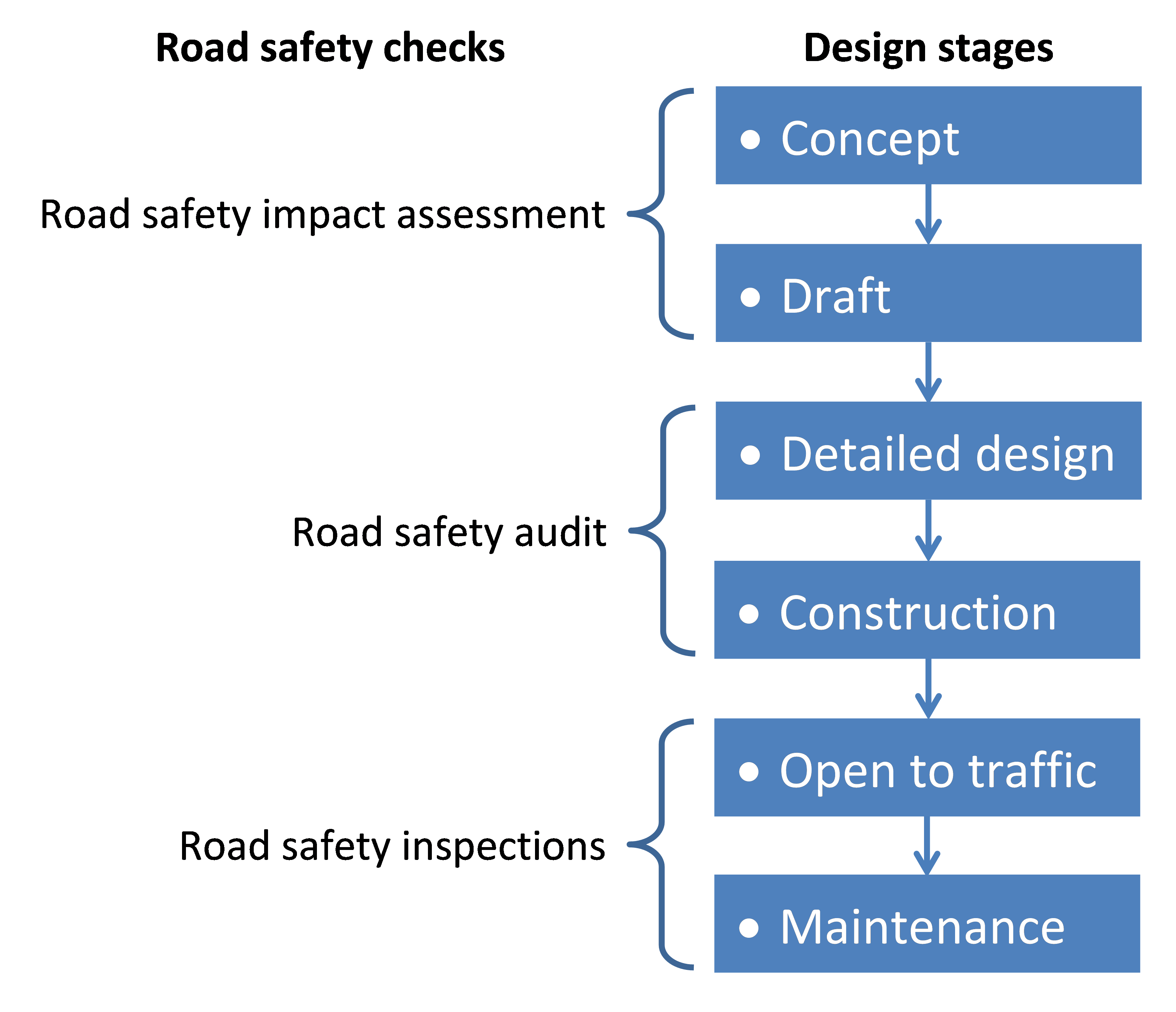
Some of the main objectives and benefits of undertaking any of these road safety checks include (PIARC 2012a):
The different road safety check types are thoroughly outlined in a number of national guidelines, some of which are available internationally. Example guidelines are provided throughout the remainder of this chapter.
Other tools to assess safety at the planning and development stage are included in Management Tools. Some of these tools are designed for use by practitioners with little or no road safety experience, and are intended to identify and address risk at the earliest stages of project and programme development.
Road safety checks generally follows a similar managerial procedure. This is outlined in Figure 10.7, which also indicates who has responsibility for each stage of the process.
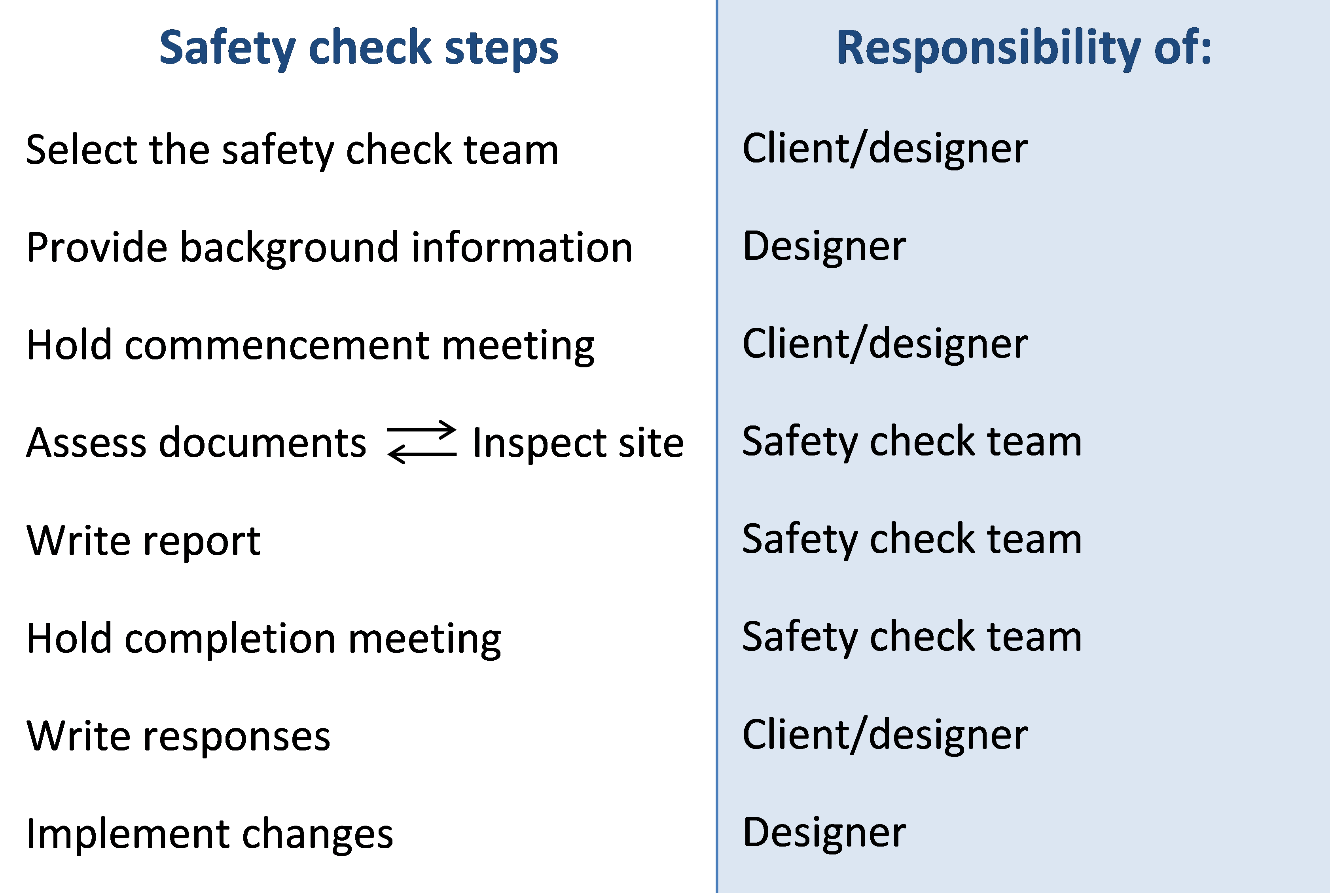
Road safety impact assessment is conducted for infrastructure projects at the initial planning stage before the infrastructure project is approved. It indicates the road safety considerations which contribute to the selection of the proposed solution and provides all relevant information necessary for a cost-benefit analysis of the different options assessed. This allows a comparison of the impact of different road or traffic schemes on safety performance. These could be for a new road or for modification to an existing road. This is a procedure that should first be performed in the initial planning stage of a project to assist in the selection process for major infrastructure projects, and should then be continually reviewed during the draft design phase. Safety impact assessment often precedes road safety audit (Road Safety Audit in Proactive Identification), but is done as a complementary process. As identified in Examples of Infrastructure Policies, Standards and Guidelines in Policies, Standarts and Guidelines, impact assessment is required for all infrastructure projects on the trans European network as part of an EU Directive.
There are five main steps to a road safety impact assessment, as outlined by Eenink et al. (2008):
1. Establish the baseline situation (year zero). This should be a measurement in terms of traffic volumes, crashes per road type, and therefore risk factors per road type. A site inspection is required to collect this data (see Diagnosing the Problem in Crash-based Identification (‘Reactive’ Approaches) for further detail regarding site inspections). The site inspection should consider all road users, the surrounding road network, topography, local amenities and activity centres, local weather conditions, previous road safety reviews, and any complaints received from the community regarding the site.
2. Determine the future situation without any implemented measures (known as the ‘Do Nothing’ or ‘Do Minimum’ scenario). This should consider current circumstances and conditions, and should account for traffic growth.
3. Determine the future situation under each of the applied road safety schemes. This should include a wide variety of alternatives and an estimate of the effects per road type. It should consider each road user group for each of the schemes. Each scheme should be measured in terms of its impact on the number of crashes and crash severity through a crash prediction model (see AASHTO, 2010).
4. Perform cost-benefit analysis for each possible road safety scheme. This is done by assigning a monetary value to the safety impacts of each scheme, and allows for the schemes to be ranked in order of effectiveness.
5. Optimize the plans of each scheme. This is done to achieve the optimal safety effect and best cost-benefit rating.
A detailed final report should be completed at the end of the road safety impact assessment. This should include such details as:
During a road safety impact assessment it is important to ask certain questions. Are the road safety policy targets realistic or ambitious? Are there other cost-effective schemes that have not been considered yet? Are the selected schemes suitable, not just in terms of safety, but in terms of other issues such as impacts on the environment, or accessibility and connectivity for all road users? Are there any associated social issues, such as a lack of support from the community?
It is important to note that a road safety impact assessment does not replace a road safety audit; it is merely a preliminary step towards selecting the most beneficial design for a project. Road safety audits are essential for ensuring all hazards are identified throughout the detailed design and construction processes, which will be discussed in detail in Road Safety Audit in Proactive Identification.
Part C of the Highway Safety Manual (AASHTO, 2010) provides information on crash prediction models for different road types, including rural two-lane, two-way roads, rural multi-lane highways, and urban and suburban arterials. It covers both undivided and divided roadway segments, and intersections with various control devices and numbers of legs. This can be used to predict the expected average crash frequency, which is determined based on traffic volumes and roadway characteristics. More on the Highway Safety Manual can be found in Box 10.3.
The IHSDM is a suite of software for evaluating the safety and operational effects of geometric design decisions (from design plans). These are advanced safety analysis and prediction tools, and considered ‘best practice’ by many safety professionals (see e.g. Schermers et al., 2011).
The development of these tools is based on a wide and robust range of research including on crash prediction models and crash modification factors (CMFs) undertaken mainly in North America over the last 15 to 20 years. IHSDM is particularly useful for selecting the safest option from a list of possible options and for understanding the safety trade-off that might result from a lower standard design that may be required due to site constraints or construction cost savings. This tool uses crash prediction models and CMFs to predict crash occurrence. The models and CMFs are continually being refined as new research becomes available. IHSDM has calibration procedures that allow it to be customised for each US state or for other jurisdictions. Testing of these procedures has occurred in some European countries as well as Australasia.
The international Road Assessment Programme (iRAP) has developed a technique to star rate design plans. Although not strictly an impact assessment, the process fulfils a similar purpose. Details on this approach can be found in the case study in Management Tools.
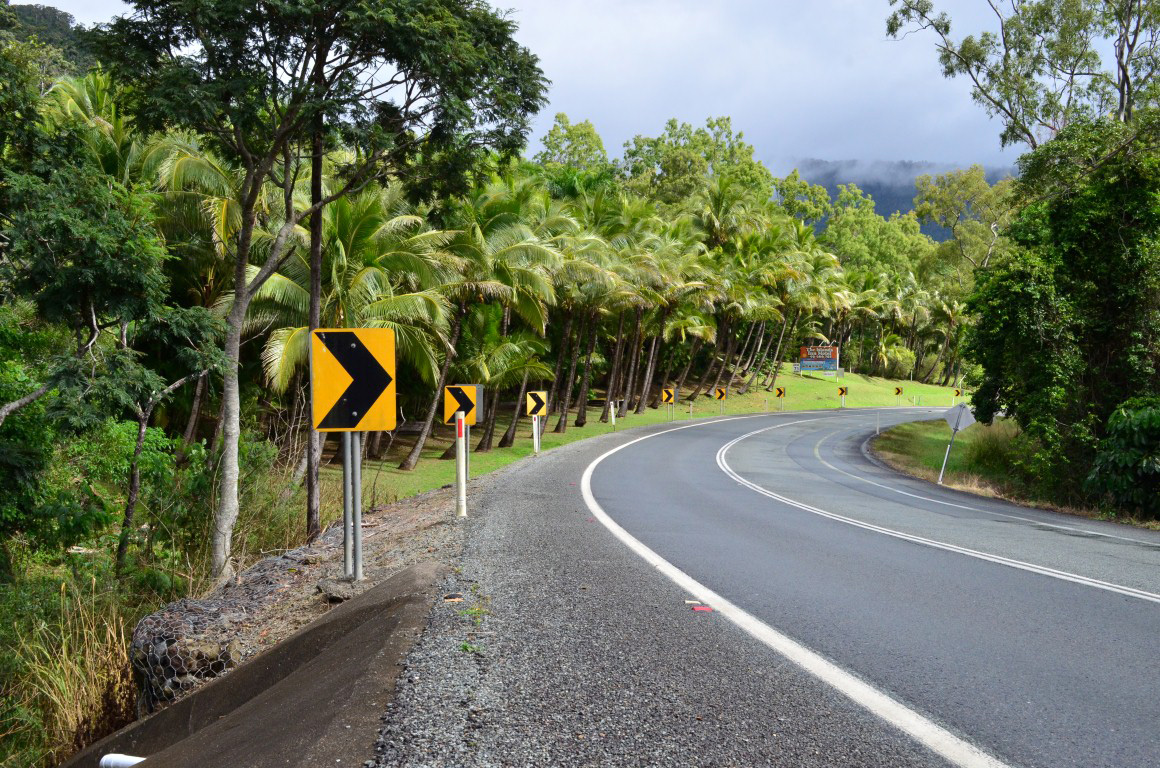
A road safety audit is defined as a formal and independent technical check of a road scheme design and construction, to identify any unsafe features or potential hazards and to provide recommendations for rectifying them during all stages, from planning to early operation (PIARC, 2011; ETSC, 1997; NRA, 2012).
The main aim of a road safety audit is to identify and address any road safety issues. A road safety audit is not a check against design standards, but a hazard detection tool. A road scheme, when audited, should be analysed under all operating conditions and consider all road users.
Road safety audit is thought to be a cost-effective measure for identifying and addressing likely safety issues. The earlier the audit is undertaken, the greater the benefit, as adjusting design plans can be a cheaper option than retrofitting safety features once a scheme has been built. Several studies have documented the benefits of conducting road safety audits. As an example, Macaulay and McInerney (2002) estimated that a sample of design stage audits had a benefit cost ratio (BCR) of between 3:1 and 242:1 by implementing all the recommendations from individual audits. In addition, 75% of recommendations had a BCR greater than 10, and 90% of recommendations had a BCR greater than 1.
Road safety audits (as well as other proactive methods) are very important for LMICs, as they provide an opportunity to develop a culture of road safety amongst those responsible for the planning and delivery of road infrastructure. On this basis alone there is a very strong case for the development of a formalised process for road safety audits for all major infrastructure projects.The Kazakhstand case study provides an example of some of the added benefits that can be gained from large road safety audit projects in LMICs.
Many international guides exist on how to conduct road safety audits. PIARC developed a Road Safety Audit Guide (2011; www.piarc.org/ressources/publications/7/6852,WEB-2011R01-TM.pdf) that provides a comprehensive step-by-step procedure on how to conduct a road safety audit, as well as providing detailed individual checklists for motorways, inter-urban and urban main roads at each of the design stages (feasibility study, preliminary design, detailed design, and pre- and post traffic opening). The guide also provides checklists for road safety audit, which are discussed in more detail below. Other useful guides include the FHWA Road Safety Audit Guidelines (2006; also see http://safety.fhwa.dot.gov/rsa/) and the Austroads Guide on Road Safety Audit (2009b). The African Development Bank (2014b) has recently released guidance that is specifically intended for use in LMICs.
A road safety audit may be undertaken through planning, design and operations, as well as,other circumstances, for example to assess the safety of proposed traffic management at roadworks, particularly in busy and complex situations.
As identified in Section Examples of Infrastructure Policies, Standards and Guidelines in Policies, Standarts and Guidelines , the EU Directive on road infrastructure safety management states that road safety audit be conducted on all infrastructure projects on the trans-national highway in Europe, and suggests that these should also occur for all national roads. The Directive also states that such audits should be conducted at the draft design, detailed design, pre-opening and early operation stages.
The PIARC (2011) guide identifies three parts in the auditing process – commissioning, undertaking and completion. Details on each of these stages are provided in that document.
The selection of an appropriately skilled audit team is an important part of the commissioning phase of the audit process. It is essential that the team is independent of the design team. The size and make-up of the team will vary depending on the size and complexity of the project and the stage of audit being undertaken. It is important that the team members, and particularly the team leader, have the necessary training to undertake a road safety audit. Many countries have developed formal training requirements (sometimes referred to within national guidance on road safety audit) and registers of appropriately qualified auditors. For smaller projects, it may be possible for a single auditor to complete a ‘road safety check’, and although this is not ideal, it is certainly preferable to no audit at all.
The availability and development of suitably skilled road safety auditors is an important challenge for those in LMICs. Capacity can be increased in the short term by training of key staff (either within their own country, or through established courses in HICs). In the medium term it is desirable to establish capacity within a country to train auditors. This will typically require some form of longer term ‘train the trainer’ approach, whereby a small number of experts are provided with advanced training and on-going support. These experts then develop skills through experience to a point where they are in a position to train others.
Many countries have developed checklists for conducting road safety audits. These checklists provide examples and reminders of issues that should be assessed by audit teams during their assessment. They are useful to ensure that key issues are considered, but it also needs to be recognised that every situation differs, and therefore checklists should typically be used as guides only. This is because there may be other issues identified during an audit that were not anticipated by the existing checklist. Different checklists have been developed for different stages of the road safety audit process, or for specialist types of audit (for example, pedestrian and bicycle audits).
One criticism of road safety audits in the past is that the recommendations from the audit are not implemented. It is therefore critical that there be a process to complete the audit, including a formal response to the report. This should document a response to each of the actions recommended; and in cases where recommendations have not been accepted, the reasons for this and any other mitigating strategy that will be undertaken to help minimise risk should be stated. This written response to the audit report should become part of the project documentation.
Harwood et al. (2014) suggested that audit was a costly method for identifying interventions, and that there is potential to miss interventions that could be added that are cost-effective ways to improve safety. Also, economic assessment of interventions is typically not included unless conducted as an addition to the normal audit process. On the positive side, they suggest that audit is a useful way to identify safety features that are missing or in poor condition, and that they are a good way to bring together expert staff to review safety. They also identified advantages in conducting field reviews (i.e. site inspections), a process not always undertaken in other methods of risk assessment.
It is important to note that the road safety audit process has been around for many years. It was first established in the late 1980s, with documentation developed in many countries from the 1990s. However, there has been little recent adjustment of the road safety audit process to include Safe System concepts. In some countries, the focus is shifting to better capture issues related to eliminating death and serious injury, although this has always been an integral part of the audit process. The focus remains primarily on road-based deficiencies and the solutions are generally aimed at improving the road environment. In many situations, this approach may be adequate; however, in an attempt to take a Safe System-based approach, some jurisdictions have developed assessment frameworks that could be considered Safe System audits. These differ to traditional audits because they focus attention on the reduction of fatal and serious casualties and/or take a more holistic view of problems (and solutions) involving each of the Safe System pillars (e.g. safe user issues such as fatigue, potential for speed related crashes). The Australia case study provides one such example.
A further example was developed by the Department of Planning, Transport, and Infrastructure (DPTI) in South Australia. This involved a full Safe System assessment for a major project, and was used as part of a successful business case to government to secure funding. The approach differed from a typical audit because it assessed vehicle and behavioural issues as well as the typical infrastructure issues. Interestingly, some of the vehicle and behavioural issues identified were able to be addressed through infrastructure changes (also see the discussion in Designing Infrastructure to Encourage Behavior).
In a recent development, quantified audits have been undertaken to determine the impact of new design. Changes can be made to this design and likely safety improvements determined. An example of this approach is provided in Management Tools.
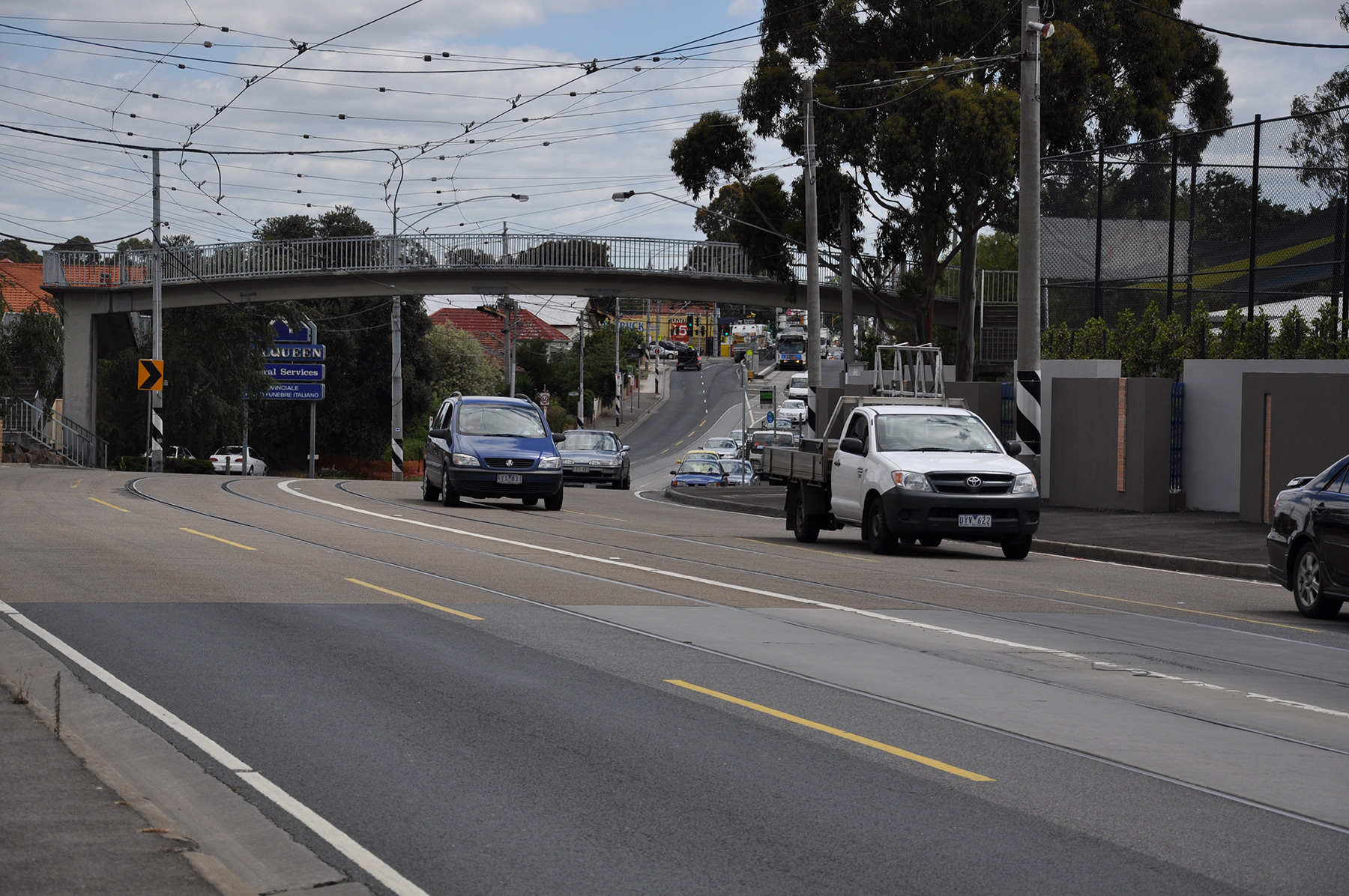
The PIARC Road Safety Inspection Guideline for Safety Checks of Existing Roads (2012a) defines a road safety inspection (RSI) as a systematic, on-site review of an existing road with the aim of identifying hazardous conditions, faults and deficiencies that may lead to serious crash outcomes. An RSI must be carried out by an independent, qualified individual or team with the relevant experience, and is specific to existing roads, not those under construction. It is also a proactive method in that the prevention of crashes is achieved through identification of potential safety issues, rather than responding to recorded crashes in a crash location investigation.
Road safety inspections are useful as they can:
The PIARC (2012a) guide identifies the following topics as necessary to be covered during an RSI, as well as some of the questions a safety check team should be considering during an investigation:
There are four main steps to a road safety inspection on an existing road.
An on-site field study component of RSI has evolved in recent years. Survey vehicles can be equipped with automated devices to measure and record design and road management elements (e.g. horizontal and vertical alignment, super-elevation, pavement surface condition, presence of roadside hazards, road inventory etc.). This information can be assessed to detect issues with routes, such as anomalies in curvature (e.g. unexpected severe curves); slippery road surface or presence of roadside hazards. Further details on this data collection can be found in Section 5.4.
A road safety inspection of an existing road aims to detect features that may lead to future crashes, and past crash information is not always a good indicator of this. Crash investigation and prevention programmes look at features that contribute to the occurrence and severity of crashes that have already happened. An RSI does not require crash data, but it can be a useful tool in terms of providing guidance towards prioritising which roads should be inspected. For instance, if the road authority only has enough funding to inspect a select number of roads, priority can be given to roads with a high number of crashes per kilometre, or crashes per traffic volume. More detail on prioritisation of policies, projects and treatments can be found in Priority Ranking Methods and Economic Assessment. Road safety inspections can be a useful complement to reactive approaches, such as high crash location investigations.
Sometimes RSI is undertaken on specific themes, for instance to identify issues relating to pedestrians or bicycles. This approach has been developed even further in France, where a method involving a specially equipped bicycle has been established to assess the bicycle network. Further information on this approach can be found at the following link: http://www.ouest.cerema.fr/IMG/pdf/120925_Securite-routiere_Velaudit_cle05dc7d.pdf.
An RSI is not the same as a routine maintenance check, where issues such as vegetation, road surface inconsistencies and poor quality signage are reviewed and remedied. However, an RSI can identify safety issues that are a result of poor maintenance, such as poor signing, line marking or visibility issues.
Road safety inspections can lead to:
Human factors are a crucial part of identifying hazards at a site. Further discussion on this issue can be found in Design for Road User Characteristics and Compliance.
Road safety inspections can be performed on the whole road network or on specific locations that are regarded as being the greatest risk. This is dependent on the road authority. It is important to note that road safety inspections of existing sites can result in a huge number of identified hazards and road safety issues. Under these circumstances, it is not economically viable to attend to all the issues listed. There is also little benefit to conducting an RSI on a site if the resources will not allow the majority of hazards to be addressed following the inspection. Sometimes it is more beneficial to invest in a maintenance programme to address a number of issues rather than conduct a formal RSI.
The PIARC Road Safety Inspection Guideline for Safety Checks of Existing Roads (2012a) provides a number of helpful checklists for different road types to ensure that each investigation of a site considers all the necessary elements. The checklists are similar in nature to those used for road safety audit. The guide also provides examples of appropriate RSI reports for both inter-urban and urban main roads. The African Development Bank (2014c) has recently released guidance on Road Safety Inspection that is specifically intended for use in LMICs.
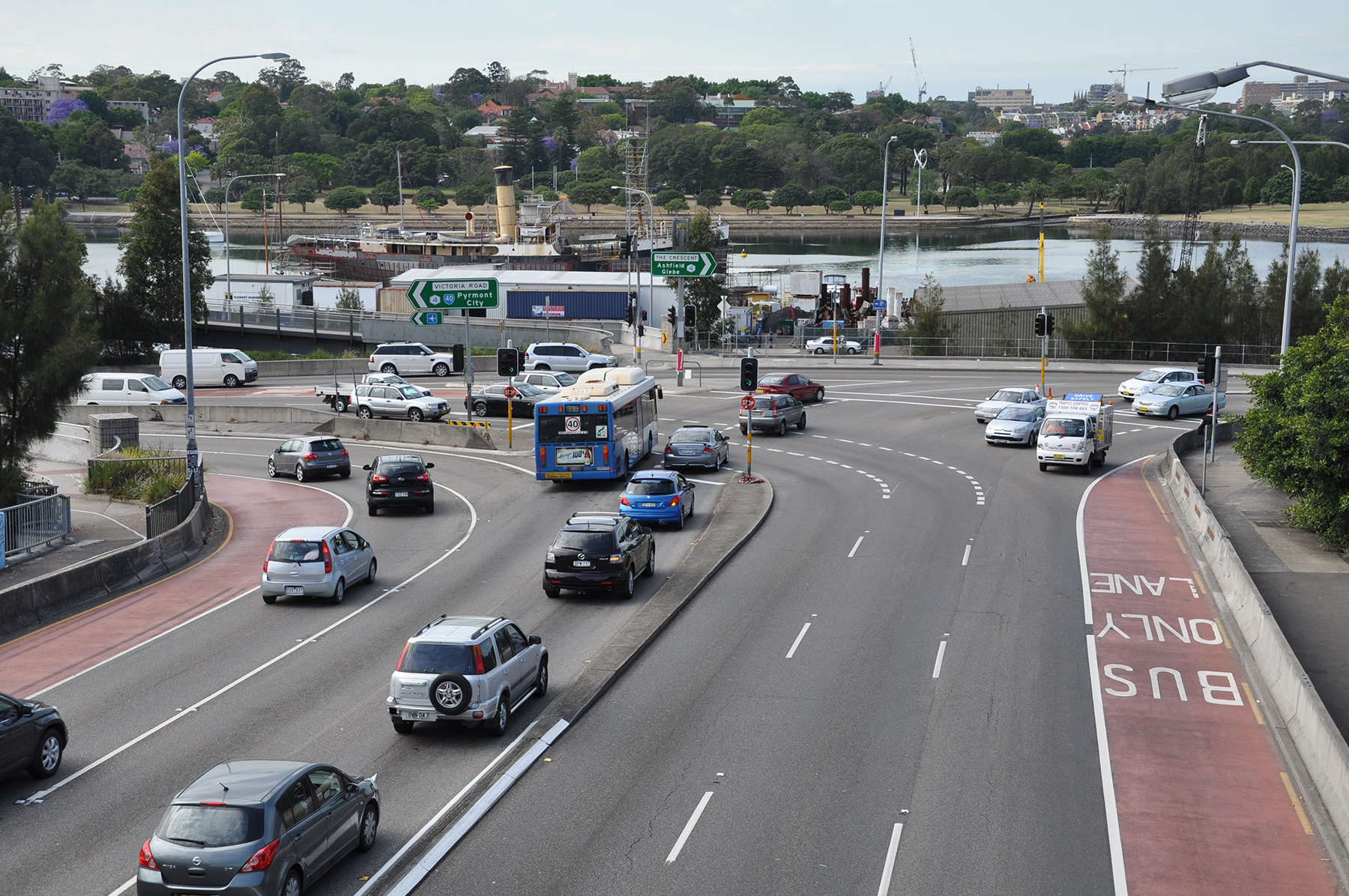
Recognizing the critical need to improve pedestrian infrastructure quality and safety, PIARC developed the Walkability Checklist and the Checklist for Quality and Safety Inspections of Pedestrian Infrastructure. Both of these Checklists are discussed in detail in the following article: Pedestrian Audits - A Checklist for Safety and Quality Inspection of Pedestrian Infrastructure. The intent of these checklists are to find optimal solutions for walking and sojourning. The checklists incorporated Rumar's order of problems approach, where there orders of requirements are defined in three levels (Rumar, 2002). The first level requirements are those visible, tangible and concrete requirement concerning the physical environment, pedestrians, vehicles and the behaviours of other road users. The second order requirements concern the tactical level facilities and services, such as how the network is designed and operates, the traffic rules, and enforcement, management of the system and other like elements. The third order requirements allow the first and second order requirements to be met. These include land use characteristics, mode split, pedestrian quality, the culture, and other aspects that relate to the ease and desire to walk. The Walkability Checklist considers the design of the roadside environment as first order requirements, with traffic rules and traffic flow as second order requirements. The checklist recognise that requirements go beyond objects, facilities and services to consider context, process and procedures. The Walkability Checklist reviews pedestrian quality elements and whether general walkability requirements are fulfilled. The Checklist also helps define the stakeholders responsibilities for the walkability requirements under consideration and what procedures need to be applied.
The Checklist for Quality and Safety Inspections of Pedestrian Infrastructure (CQSI) builds upon the Pedestrian Quality Needs (PQN) Inspection process. In general, the PQN is a systemic onsite expert review of the walking condition requirements through identification of hazardous conditions, faults and deficiencies that reduce pedestrian demand, conditions, comfort and safety. Because the PQN considers the quality and safety concerns of the pedestrian infrastructure, the CQSI was developed as the next step to the PQN. The checklist is intended to identify all of the relevant deficiencies of the pedestrian infrastructure. The photo below provides an example of a pedestrian deficiency that might be identified through the pedestrian audit process.
The proactive approach has been extended with a method that takes a quantified approach to the inspection of existing roads and road designs. Although several approaches exist, the most commonly applied is the Road Assessment Programme (RAP). Different RAP programmes exist in different regions, including EuroRAP, USRAP, AusRAP, KiwiRAP and ChinaRAP. These all fall under the global banner of iRAP (the International Road Assessment Programme). PIARC (2012b) notes that the iRAP approach is of great benefit where crash data is unavailable or coverage is limited.
RAPs take the concept of road safety audit and inspection a step further by estimating the risk (based on likelihood and severity) for different road sections based on road and roadside characteristics. A number of road elements are collected (e.g. through video and subsequent desk-based assessment; also see Non Crash data and Recoding Systems). Based on research conducted over many years, a lot is known about each of these variables, and the level of risk each produces. As an example, a straight section of road is safer than a road with a severe bend, and this risk level can be quantified. Each of the variables is quantified and an algorithm determines the risk of a fatal or serious injury for each segment of road (iRAP uses 100 m segments).
Such an assessment can be used to identify the highest risk and lowest risk segments of a network or road. A five-star rating system is used, with a one-star road providing the poorest road infrastructure, while on a five-star road the likelihood of a crash occurring and the severity of those that do occur is lowest. This information can also be colour-coded to provide a quick visual indication of road infrastructure safety. The process also allows separate star ratings for different types of road user (e.g. the vehicle occupant, pedestrian, bicyclist and motorcyclist).
The information can also be used to identify safety improvements that may be implemented, both at specific locations and across a whole network. Calculations can be updated to determine the likely safety benefit from such improvements. With knowledge of treatment costs and their benefit, as well as estimates of fatal and serious crash outcomes for a road network, an economic calculation can be undertaken to determine the most beneficial group of treatments to be applied to a road network or at a location. The software for this analysis is available online, and is provided free to road authorities to use. Further details on this can be found in Intervention Selection and Identification while a detailed description of the iRAP approach can be found at www.irap.org.
Reflecting the strong empirical basis behind the iRAP model, there is a strong linkage between the star rating of a road and the actual safety performance. An analysis performed by McInerney & Fletcher (2013) based on star ratings and crash cost (the average vehicle occupant fatal and serious injury crash costs per vehicle kilometre travelled) for almost 1,700 km of highway provides an example of this relationship. For each reduction in star rating (i.e. improvement in safety), the crash cost roughly halved. When moving from 1 star to 2, the crash cost reduced by 40%; from 2 star to 3 costs reduced by 61%; and from 3 star to 4 costs reduced by 44%.
Harwood et al. (2014) assessed the US RAP tools and compared this approach to other methods of assessing risk. They suggested that the approach was the most robust and quantitative in selecting interventions to improve safety, and that the recommendations were accompanied by economic assessment often missing in other methods. However, the approach was also identified as being quite labour intensive, with reliance on collecting roadway data and the coding of this data by skilled staff. However, they also suggested that this could be accomplished in a reasonably efficient manner. The consideration of risks associated with specific road user groups (motorcyclists, pedestrians, bicyclists as well as vehicle occupants) was also seen as an advantage.
A similar approach was adopted in South Africa, with the use of Netsafe